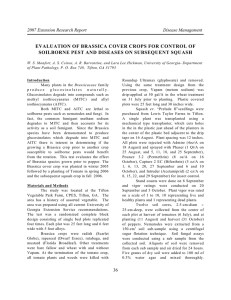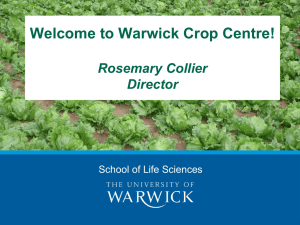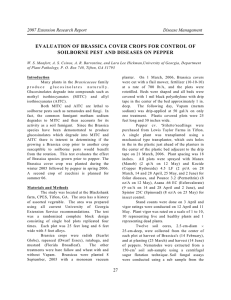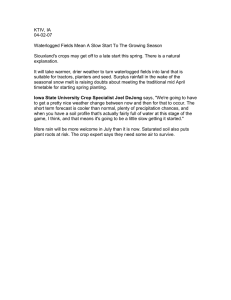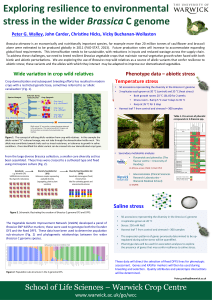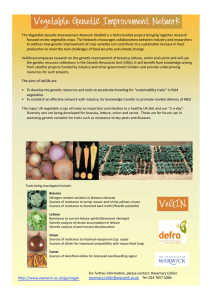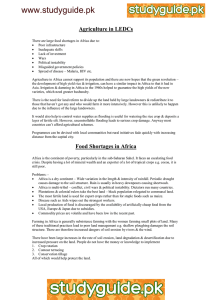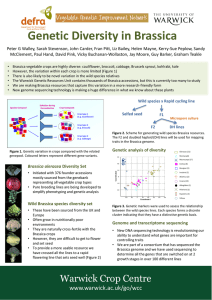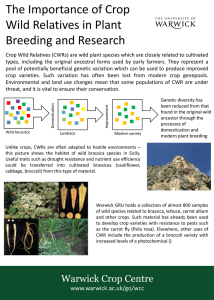EVALUATION OF BRASSICA COVER CROPS FOR CONTROL OF Disease Management
advertisement
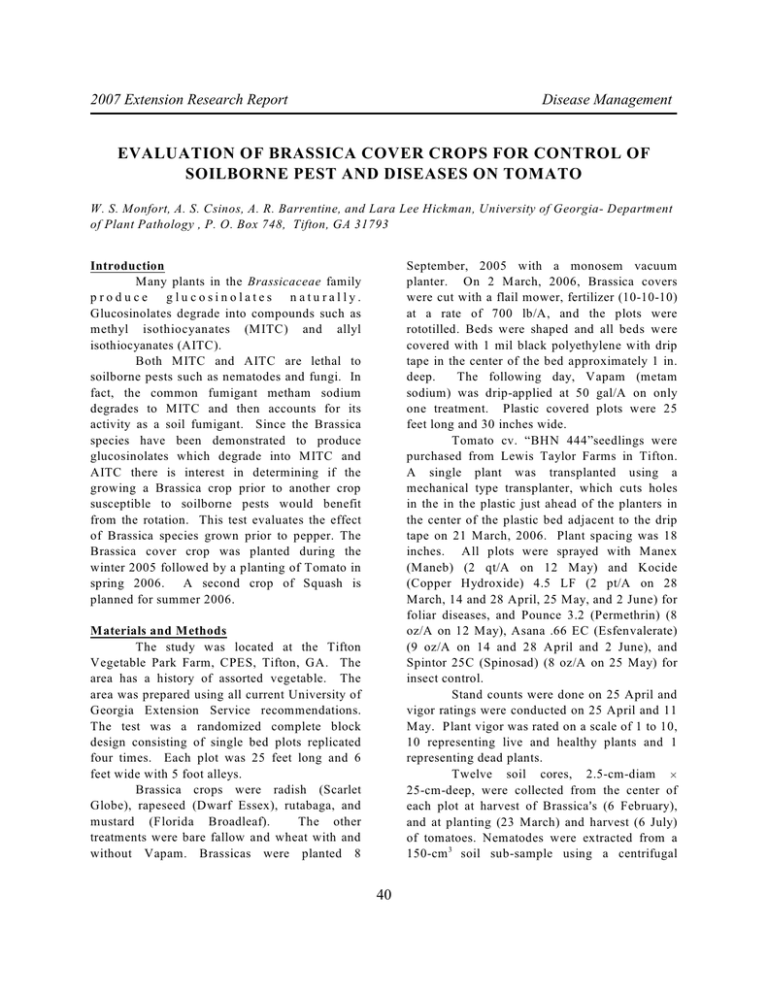
2007 Extension Research Report Disease Management EVALUATION OF BRASSICA COVER CROPS FOR CONTROL OF SOILBORNE PEST AND DISEASES ON TOMATO W. S. Monfort, A. S. Csinos, A. R. Barrentine, and Lara Lee Hickman, University of Georgia- Department of Plant Pathology , P. O. Box 748, Tifton, GA 31793 September, 2005 with a monosem vacuum planter. On 2 March, 2006, Brassica covers were cut with a flail mower, fertilizer (10-10-10) at a rate of 700 lb/A, and the plots were rototilled. Beds were shaped and all beds were covered with 1 mil black polyethylene with drip tape in the center of the bed approximately 1 in. deep. The following day, Vapam (metam sodium) was drip-applied at 50 gal/A on only one treatment. Plastic covered plots were 25 feet long and 30 inches wide. Tomato cv. “BHN 444”seedlings were purchased from Lewis Taylor Farms in Tifton. A single plant was transplanted using a mechanical type transplanter, which cuts holes in the in the plastic just ahead of the planters in the center of the plastic bed adjacent to the drip tape on 21 March, 2006. Plant spacing was 18 inches. All plots were sprayed with Manex (Maneb) (2 qt/A on 12 May) and Kocide (Copper Hydroxide) 4.5 LF (2 pt/A on 28 March, 14 and 28 April, 25 May, and 2 June) for foliar diseases, and Pounce 3.2 (Permethrin) (8 oz/A on 12 May), Asana .66 EC (Esfenvalerate) (9 oz/A on 14 and 28 April and 2 June), and Spintor 25C (Spinosad) (8 oz/A on 25 May) for insect control. Stand counts were done on 25 April and vigor ratings were conducted on 25 April and 11 May. Plant vigor was rated on a scale of 1 to 10, 10 representing live and healthy plants and 1 representing dead plants. Twelve soil cores, 2.5-cm-diam H 25-cm-deep, were collected from the center of each plot at harvest of Brassica=s (6 February), and at planting (23 March) and harvest (6 July) of tomatoes. Nematodes were extracted from a 150-cm 3 soil sub-sample using a centrifugal Introduction Many plants in the Brassicaceae family produce glucosinolates naturally. Glucosinolates degrade into compounds such as methyl isothiocyanates (M ITC) and allyl isothiocyanates (AITC). Both MITC and AITC are lethal to soilborne pests such as nematodes and fungi. In fact, the common fumigant metham sodium degrades to MITC and then accounts for its activity as a soil fumigant. Since the Brassica species have been demonstrated to produce glucosinolates which degrade into MITC and AITC there is interest in determining if the growing a Brassica crop prior to another crop susceptible to soilborne pests would benefit from the rotation. This test evaluates the effect of Brassica species grown prior to pepper. The Brassica cover crop was planted during the winter 2005 followed by a planting of Tomato in spring 2006. A second crop of Squash is planned for summer 2006. Materials and Methods The study was located at the Tifton Vegetable Park Farm, CPES, Tifton, GA. The area has a history of assorted vegetable. The area was prepared using all current University of Georgia Extension Service recommendations. The test was a randomized complete block design consisting of single bed plots replicated four times. Each plot was 25 feet long and 6 feet wide with 5 foot alleys. Brassica crops were radish (Scarlet Globe), rapeseed (Dwarf Essex), rutabaga, and mustard (Florida Broadleaf). The other treatments were bare fallow and wheat with and without Vapam. Brassicas were planted 8 40 sugar flotation technique. Soil fungal assays were conducted using a sub sample from the collected soil. Aliquots of soil were removed from each sub sample and air dried for 24 hours. Five grams of dry soil were added to 100 ml of 0.3% water agar and mixed thoroughly. Immediately afterward, 1 ml of soil/agar was removed and mixed with 20 ml of 0.3% water agar. One ml of the first preparation was dispensed and spread evenly onto a petri plate containing an oomycete-selective medium (p im aricin -am p cillin-rifam picin -P C N B ) for isolation of Pythium species. One ml of the second preparation was dispensed and spread onto a petri plate containing a Fusariumselective medium (peptone-PCNB). Fungal plates were incubated for 120 hours for Fusarium species and 48 hours for Pythium species. After incubation, CFUs were counted and recorded. On 25 April an early root gall evaluation was conducted on three plants per plot using a 0 to 10 scale, whereby, 0 = no galls, 1 = very few small galls, 2 = numerous small galls, 3 = numerous small galls of which some are grown together, 4 = numerous small and some big galls, 5 = 25 % of roots severely galled, 6 = 50 % of roots severely galled, 7 =75 % of roots severely galled, 8 = no healthy roots but plant is still green, 9 = roots rotting and plant dying, 10 = plant and roots dead. Again following final harvest on 30 June five plants per plot were evaluated for root galls using that same scale. All tomato fruits were hand harvested from the 10 foot center area of each bed. Each harvest was separated into marketable and cull fruits, counted and weighed. There were a total of three harvests, 13, 20 and 30 June. numerical rate of growth compared to the other treatments on 25 April and 11 May (Table 1). Root-knot nematode pressure in this test was minimal where only a few plots were observed with any measurable soil populations (Table 2). Damage resulting from the infection and feeding of root-knot nematodes in the noted plots were also minimal. Therefore, no conclusions can be made on the affects of the treatments on rootknot nematode and their resulting damage (Table 2). Evaluation of the affects of Brassica species on soil fungal organisms showed that Pythium and Fusarium species were not significantly affected by the incorporation of the Brassica cover crops except for Fusarium at harvest of tomatoes where rapeseed, rutabaga, mustard, and the wheat treatments had the lowest CFU’s compared to radish and the control fallow treatments (Table 3). Affects of the Brassica and nonBrassica treatments were also evaluated on tomato vegetable crop. The results indicated that the control fallow treatment had the highest yield in marketable number and weight with the radish treatment having the lowest yields in both marketable fruit weight and number (Table 4). Results for the number and weight of culled fruit were similar among all treatments (Table 4). Results of total fruit number and weight indicated that the control fallow had the highest number of fruit and rutabaga had the highest fruit weight numerically compared to the other treatments with the lowest fruit number and weight being recorded in the radish cover crop treatment (Table 4). The results of this test indicated that some cover crop treatments had a beneficial affect on crop growth and yield. This increase in crop growth and yield might be the result of increased biomass and/or nutrients. Although previous tests have demonstrated nematicidal and fungicidal activity from Brassica species, the affect of the treatments in this test on n em atod es and fun gal organ ism s w ere inconclusive due to low pest pressure during the spring. Results and Summary Tomato stand counts were significantly higher in radish and mustard compared to the wheat cover crop treatments alone. The radish treatment was also significantly higher than the rutabaga treatment in plant stand counts (Table 1). Evaluation of the cover crop affects on plant vigor showed that the wheat with Vapam, rapeseed, and mustard treatments had the highest 41 42 43
